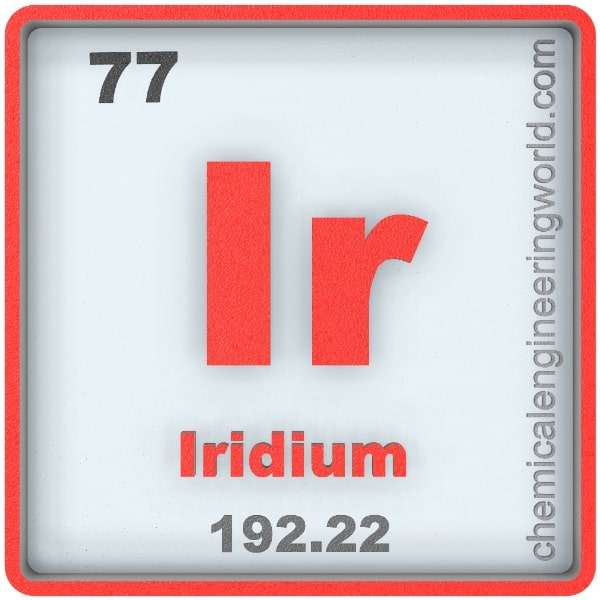Iridium Element Properties and Information

Iridium Element Properties and Information
Iridium is 77th element on the periodic table. Elements are arranged in the periodic table on the basis of the atomic number. Atomic number is the number of protons in the nucleus of the atom. Iridium has an atomic number of 77. It is located in the Group 9 and Period 6 of the periodic table of elements. It is denoted by Ir. The name is derived from the Greek goddess of rainbow, Iris.
Smithson Tennant added impure platinum to a dilute solution of aqua regia and
observed that not all metals went into the solution. He investigated the residues
further and was able to separate two new metals in 1803; Osmium and Iridium.
A very thin layer of Iridium exists on the Earth’s crust, it is theorized that whatsoever iridium is present on Earth was brought from outer space via a meteor impact. It is also said that this could have been the same meteor which wiped out the dinosaurs from earth. Iridium is found uncombined in nature and is one of the rarest element on Earth.
Physical Properties
- Iridium is a very hard & brittle transition metal which finds its place in the platinum group. It is white in appearance.
- The atomic mass of iridium is 192.2.
- The melting point of iridium is 2450°C.
- The boiling point of iridium is 4527°C.
- The density of iridium is 22400 in S.I. units at 20°C.
- Iridium is second densest naturally occurring metal after Osmium.
- Iridium’s modulus of elasticity is second highest among all metals, Osmium’s the highest.
- Iridium has only two naturally occurring stable isotopes; iridium-191 and iridium-193.
Chemical Properties
- Iridium is the most corrosion resistant metal known till now.
- Iridium compounds display oxidation state between -3 to +9.
- The only well characterized iridium compound is iridium dioxide.
- Iridium reacts with all halogens to form trihalides.
- The organoiridium compounds are generally found to exists in lower oxidation states.
Methods of Production
Electrorefining: Iridium is obtained as a by-product during electrorefining of nickel and copper, during the process gold, silver, and platinum group metals (which contains iridium) settles at the bottom as the anode mud. The mud is fused with sodium peroxide and dissolved in aqua regia. A series of liquid-liquid separation method is used to extract iridium chloride complex from the solution which is then reduced by hydrogen to yield the metallic powder iridium.
Relevance in Chemical and Related Industries
- Alloys: Due to qualities of iridium, it is used to make low-wear corrosion resistant alloys.
- Catalyst: Iridium catalysts are used in carbonylation of methanol and decomposition of hydrazine.
Relevance in Other Industries
- SEMs: The non-conductive materials are coated with iridium before being examined by scanning electron microscopes (SEMs).
- Optics: X-ray application mirrors are coated with iridium as it proves to be one of the best reflectant of X-ray.
Health Effects on Exposure
Irritant: Contact with skin and eyes causes irritation, ingestion and inhalation also causes irritation of the organs.
Effects on Surroundings
- Water bodies: Iridium must not be brought in contact with water bodies as it is soluble in water and dissolves in it.
References:
https://en.wikipedia.org/wiki/Iridium
https://www.lenntech.com/periodic/elements/ir.htm
































